
What is climate control and how does it work
Content
- Climate control in the car
- What is climate control?
- How does climate control work?
- Features of the climate control
- How to use climate control correctly
- Dual-zone climate control
- Three-zone climate control
- Four-zone climate control
- What is the difference between climate control and air conditioning
- Operation of climate control in cold weather
- Pre-heating the vehicle interior
- Installation of climate control
- What to do when climate control does not work
- Prevention of malfunction
- Pros and cons of the system
- Climate control videos
- Questions and answers:
Climate control in the car
Climate control is one of the options of the comfort system, which many modern cars are equipped with. It allows you to create the optimal temperature in the cabin, both in winter and in summer.
What is the peculiarity of this system? What is the difference between the standard version and the modification for several zones and how does it differ from the air conditioner?
What is climate control?
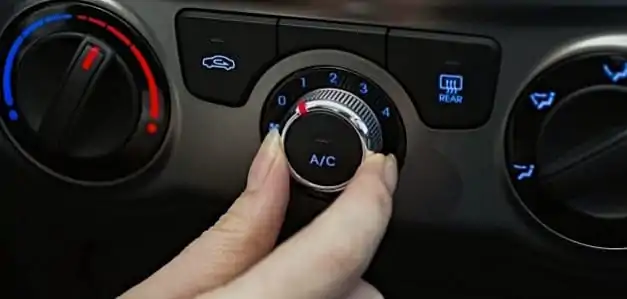
This is a system that provides autonomous climate control in the car. It is equipped with manual tuning and the Auto function. With its help, it is possible to provide heating (or cooling) of the entire space in the car or a separate part thereof.
For example, in the summer it is often hot in a car. Usually in this case windows are slightly lowered. At the same time, the air flow is difficult to control. As a result, a cold or otitis media. If you turn on the fan, it will drive hot air. The climate control system itself adjusts the operation of the air conditioner or heater, depending on a pre-set parameter.
Initially, a stove fan was used to supply cool air to the machine. In the mine, he goes past the heating radiator and is fed into the deflectors. If the air temperature in the street is high, then there is practically no benefit from such airflow.
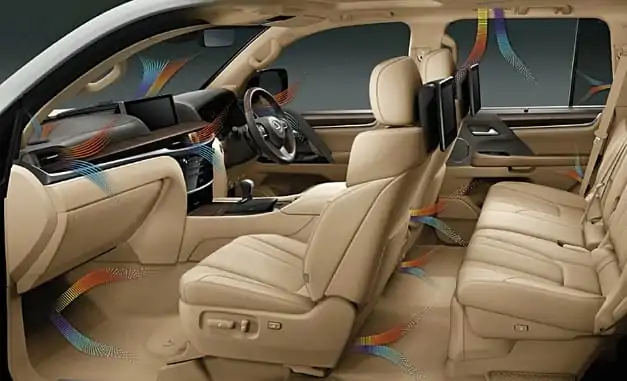
After air conditioners began to be used in American office space in the early 1930s, automakers set out to equip cars with a similar system. The first car with air conditioning installed, appeared in 1939. Gradually, this equipment was improved and instead of devices with manual tuning, automatic systems began to appear, which themselves cooled the air in the summer, and heated it in the winter.
On whether it is possible to use air conditioning in the winter, see this video:
How does climate control work?
This system cannot be called separate equipment installed in the car. This is a combination of electronic and mechanical devices that maintain a microclimate in a car without the need for constant monitoring by humans. It consists of two nodes:
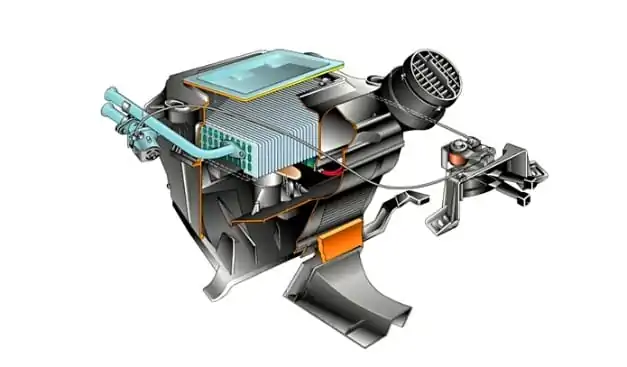

- The mechanical part. It includes air duct flaps, a heating fan and air conditioning. All these nodes are combined into a single system, so that individual elements work synchronously, depending on the settings.
- The electronic part. It is equipped with temperature sensors that monitor the climate in the cabin. Based on these parameters, the control unit either turns on cooling or activates heating.
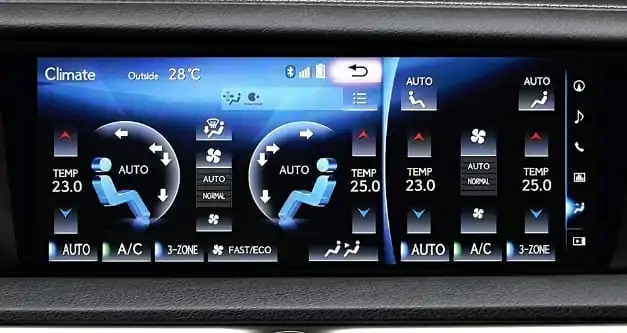

Climate control can be used at any time of the year. The system works as follows.
- The required temperature level is set on the control module (the corresponding indicator is selected on the screen).
- Sensors located around the cabin measure air temperature.
- If the sensors and the system settings do not match, the air conditioner turns on (or turns off).
- While the air conditioner is on, the supply air fan delivers fresh air through the ventilation shafts.
- With the help of deflectors located at the end of the ducts, the flow of cool air can be directed not to the person, but to the side.
- If the temperature drops, the electronics activate the heater damper actuator and it opens. The air conditioner is off.
- Now the flow goes through the radiator of the heating system (you can read about its structure and purpose in another article) Due to the high temperature of the heat exchanger, the flow heats up quickly, and heating starts to work in the cabin.
The advantages of such a system are that the driver does not need to constantly be distracted from driving a car to adjust the climate equipment. The electronics themselves take measurements, and depending on the initial setting, turns on or off the necessary system (heating / cooling).
The following video is devoted to the operation of the air conditioner in the "Auto" mode:


Watch this video on YouTube
Climate control performs several functions at the same time
The climate control functions include:
- Maintaining the optimum temperature in the car;
- Automatic adaptation to changes in the temperature of the cabin;
- Changing the level of humidity in the car interior;
- Purification of the air in the passenger compartment by circulating air through the cabin filter;
- If the air outside the car is dirty (for example, the vehicle is driving behind a smoking car), then the climate control can use air recirculation in the passenger compartment, but in this case it is necessary to close the damper;
- In some modifications, it is possible to maintain the microclimate in certain areas of the car interior.
Features of the climate control
This is not to say that this option in the car is a panacea for all the inconveniences associated with unpleasant weather conditions. Here are common difficulties that may arise when using it.
1. Some motorists mistakenly believe that the presence of a climate control system will provide a quick warm-up of the passenger compartment in winter. It should be remembered that this function depends only on the temperature of the engine coolant.
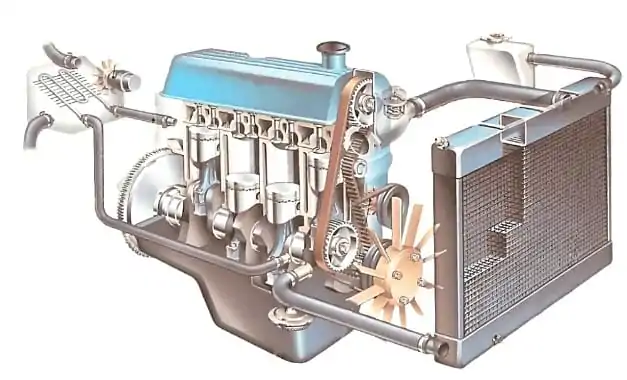

Initially, antifreeze circulates in a small circle so that the engine warms up to operating temperature (read how it should be, read here) After the thermostat works, the liquid begins to move in a large circle. Only at this moment does the radiator of the stove begin to heat up.
In order for the car interior to heat faster than the engine cooling system itself, you need to purchase an autonomous heater.
2. If the car is equipped with this system, you need to be prepared for excessive fuel consumption. In summer, this is due to the work of additional attachments (air conditioning compressor), which is driven by a timing drive. In order for the air temperature in the cabin to be maintained, constant motor operation is required. Only in this case will the refrigerant circulate through the air conditioner heat exchanger.
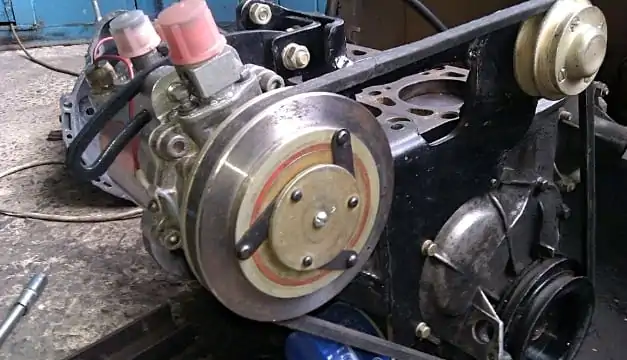

3. For efficient heating or air conditioning to work, all windows in the machine must be closed. In this case, all fresh air will enter the machine through the cabin filter. This will significantly reduce the replacement interval. And if there is a passenger in the car with symptoms of acute respiratory infections, then for the rest, the risk of infection increases.


4. Not all climate control systems in an automobile function equally efficiently. An expensive option will work softer and without sudden switching. The budget counterpart changes the temperature in the car faster, which can affect the health status of everyone in the cabin.
By default, this system is single-zone. That is, the flow goes through the deflectors installed in the front panel. In this case, the air in the cabin will be distributed from the front to the back. This option is practical for trips with one passenger. If more than a few people will be in the car, then when buying a new car, you should choose one of the following options:
- dual-zone;
- three-zone;
- four-zone.
How to use climate control correctly
Since the air conditioner, which is a key element of climate control, is part of the attachment, part of the power of the power unit is used to operate it. In order not to subject the motor to a heavy load while it reaches operating temperature, it is better not to turn on the unit.
If the inside of the car is very hot, then while the engine is warming up, you can open all the windows and turn on the cabin fan. Then, after a minute or two, you can turn on the climate control. So the driver will make it easier for the air conditioner to cool the hot air (it is removed from the passenger compartment through the windows), and also does not overload the internal combustion engine in the process of preparing it for work.
The air conditioner works better when the engine is at higher rpm, so if the climate control is turned on while the car is moving, it is better to move more lively so that it is easier for the engine to keep the compressor running. At the end of the trip, it is better to turn off the air conditioner in advance - at least a minute before stopping the power unit, so that after intensive work it will work in a light mode.
Since the air conditioner is able to decently reduce the temperature in the room, if the temperature is set incorrectly, you can get seriously ill. To avoid this, it is necessary to adjust the cooling of the passenger compartment so that the temperature difference is no more than 10 degrees. So the body will be more comfortable to perceive the difference in temperature outside and in the car.
Dual-zone climate control
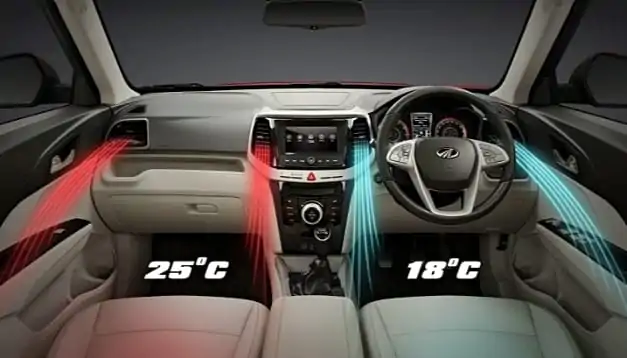

This modification differs from the previous one in that the flow can be adjusted for the driver and separately for the passenger sitting nearby. This option allows you to ensure a comfortable stay not only according to the needs of the owner of the car.
In dual-zone modifications, manufacturers set some restrictions on the difference in climate settings. This prevents an uneven distribution of heating / cooling.
Three-zone climate control
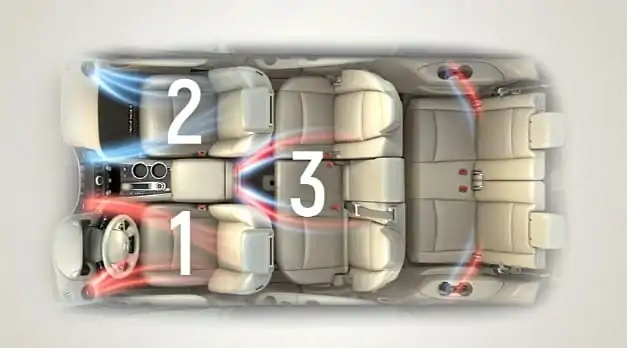

In the presence of this modification, in addition to the main controller, another control unit will be installed on the control unit - for the passenger (as in the previous modification). These are two zones. The third is the back row in the car. On the back of the armrest between the front seats is another regulator.
Rear row passengers can choose the best option for themselves. In this case, the driver will not suffer because of the preferences of those with whom he is traveling. It can optimize heating or cooling separately for the area near the steering wheel.
Four-zone climate control
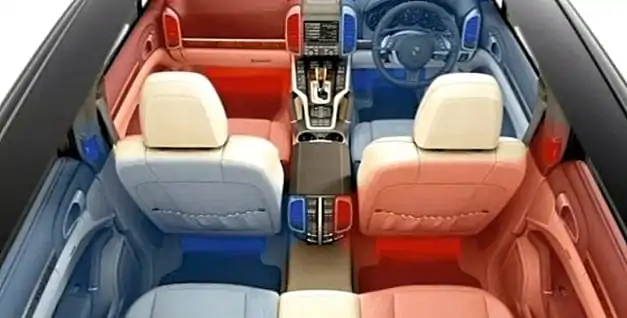

The principle of operation of the four-zone climate control is identical to the first three modifications. Only control is distributed on four sides of the cabin. In this case, the flow goes not only from the deflectors located on the back of the armrest between the front seats. Smooth blowing is also provided through the ducts on the door pillars and on the ceiling.
Like the previous analogue, zones can be controlled separately by the driver and passengers. This option is equipped with premium, luxury cars, and it is also present in some full-fledged SUVs.
What is the difference between climate control and air conditioning
How to determine if an air conditioner is installed in the car or is it also equipped with autonomous adjustment? In this case, the panel will have a separate unit with a small screen on which the temperature level will be displayed. This option is automatically equipped with air conditioning (without it, the air in the car will not cool).
The usual system of blowing and heating the passenger compartment has an A / C button and two controls. One shows the fan speed levels (scale 1, 2, 3, and so on), and the other shows a blue-red scale (cold / hot air). The second knob adjusts the position of the heater damper.
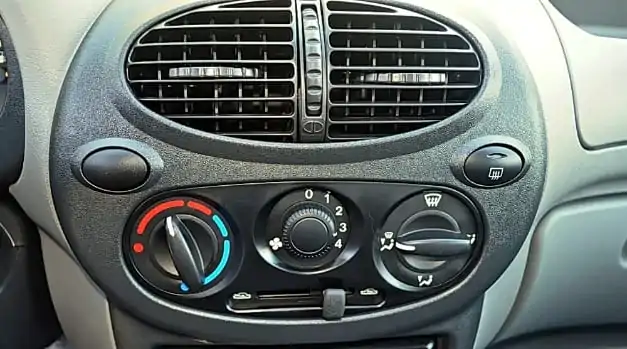

The presence of air conditioning does not mean that the car has climate control. There are several differences in these two options.
1. Setting the temperature by using the air conditioner is made "by feelings". The automatic system has a smooth adjustment. It has a screen that displays a custom metric. Electronics creates a microclimate inside the car, regardless of weather conditions on the street.
2. A standard air conditioning system either heats the cabin due to the temperature in the engine cooling system, or supplies air from the street. The air conditioner is able to cool this flow depending on the position of the regulator. In the case of an automatic installation, just turn it on and select the desired temperature. Thanks to the sensors, the electronics themselves determine what is needed to maintain the microclimate - turn on the air conditioner or open the heater shutter.
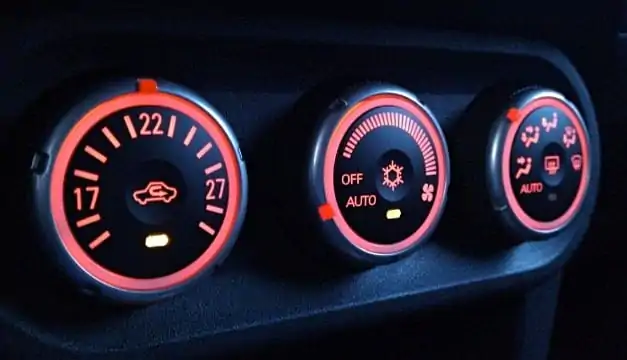

3. Separately, the air conditioner not only cools the air, but also removes excess moisture from it. This feature is especially useful if it rains outside.
4. A car equipped with air conditioning costs less than a similar model with the automatic climate control option, especially if it has a “four-zone” prefix. The reason for this is the presence of additional sensors and a complex electronic control unit.
This video details the climate control and air conditioning system:


Watch this video on YouTube
The climate control of some cars is equipped with a function of preliminary preparation for the trip. It may include heating or cooling the cabin before the driver arrives. The presence of such a function should be checked with the dealer. If it is present, then the control unit will be equipped with another regulator - setting a timer.
Operation of climate control in cold weather
In winter, the climate control works to heat the passenger compartment. For this, not the air conditioner is already involved, but the cabin heater (heating radiator through which the air blown by the cabin fan passes). The intensity of the warm air supply depends on the settings set by the driver (or the passenger, if the climate control has several zones).
In late autumn and often in winter, the air is not only cool, but also humid. For this reason, the power of the car's stove may not be enough to make the air in the cabin comfortable. If the air temperature is within zero, the air conditioner can turn on the air conditioner. This will remove excess moisture from the air, due to which it will warm up faster.
Pre-heating the vehicle interior
The vehicle's climate control can be synchronized with the starting heater of the passenger compartment. In this case, in the winter, you can set the climate control system for autonomous heating of the passenger compartment. True, for this it is important that the battery in the car is good and does not discharge too quickly.
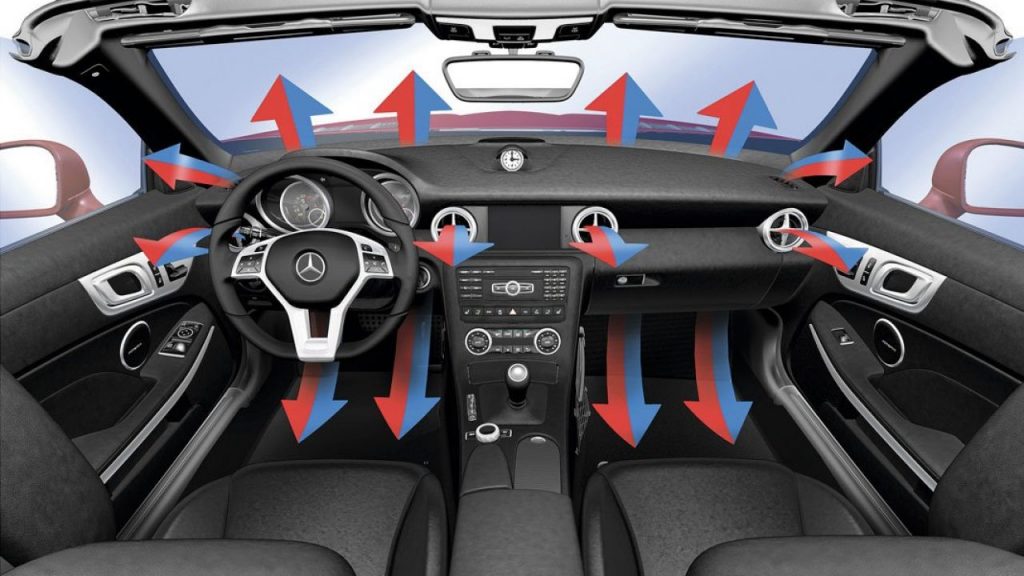

The advantage of this installation is that the driver does not need to freeze either on the street or in a cold car while the engine heats up, and with it the interior heater radiator. Some motorists turn on the stove after starting the engine, thinking that this way the interior will heat up faster.
This will not happen, because the radiator of the stove heats up due to the temperature of the coolant circulating in the engine cooling system. Until it reaches the optimum temperature, it makes no sense to turn on the stove.
Installation of climate control
Some owners of cars that are not equipped with climate control are thinking about this task. In addition to the high cost of the procedure and equipment, not every machine has the opportunity to install such a system.
Firstly, low-power atmospheric motors can poorly cope with the load from the installed air conditioner (this is an integral unit in the system). Secondly, the design of the stove should allow the installation of additional servos for automatic redistribution of air flows. Thirdly, in some cases, the installation of the system may require significant modernization of the car's electrical system.
For self-installation of climate control in a car, you must purchase:
- Wiring from a similar vehicle equipped with this system;
- The stove is from an identical model with climate control. The difference between this element and the standard one is the presence of servo drives that move the dampers;
- Temperature sensors for stove nozzles;
- Temperature sensors for central air ducts;
- Depending on the type of CC, you may need to purchase an ultraviolet and infrared sensor (determines the level of solar energy);
- Control unit (the easiest to find);
- Matching frame with switches and settings panel;
- Fan sensor and cover.
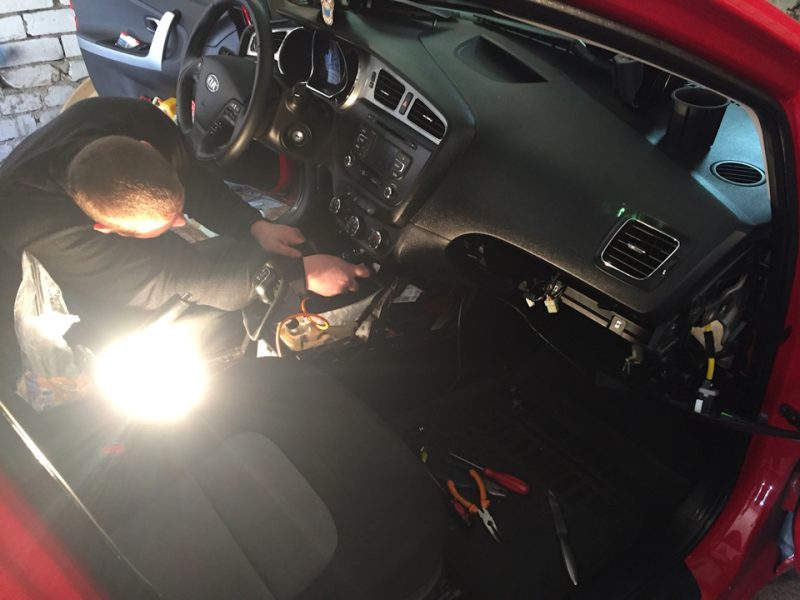

For modernization, the car owner will need to redo the dashboard so that there is where to install the system control panel and bring the wires. Wealthier motorists immediately buy a dashboard from a climate-controlled model. Some turn on the imagination and develop their own design of the control panel, which is built into the center console.
What to do when climate control does not work
Any system in a car, especially a self-installed one, including climate control, can fail. You can diagnose and fix some QC malfunctions yourself. In many car models, the system may have a slightly different device, so it is impossible to create a list of procedures that is suitable for absolutely all types of systems.
The climate control diagnostic procedure described below is based on the example of a system installed in a Nissan Tilda. The system is diagnosed in the following sequence:
- The car ignition is switched on and the OFF button on the climate control panel is pressed. The elements present in the system will light up on the screen and all their indicators will light up. This procedure boils down to determining whether all elements will be highlighted.
- The integrity of the temperature sensor circuit is checked. For this, the temperature is increased by one position. Number 2 should appear on the monitor. The system will independently check if there is any open circuit in the circuit. In the absence of this problem, a zero will appear on the monitor next to the deuce. If another number appears, then this is an error code that is deciphered in the user's manual for the car.
- The temperature on the control panel rises by one position - the number 3 will light up on the screen. This is a diagnostics of the position of the dampers. The system will independently check that the blower flap is working properly. If everything is in order, the number 30 will be displayed on the screen. If another value is displayed, then this is also an error code.
- The actuators on all dampers are checked. The temperature changeover roller is moved one more degree higher. At this stage, by pressing the button of the corresponding damper, it is checked whether air is coming from the corresponding duct (checked with the back of the hand).
- At this stage, the operability of the temperature sensors is diagnosed. It is carried out in a cold car. For this, the temperature roller is moved one more position on the control panel. The test mode is activated 5. First, the system displays the outdoor temperature. After pressing the corresponding button, the interior temperature appears on the screen. Press the same button again and the display shows the intake air temperature.
- If the readings of the sensors are incorrect (for example, the ambient and intake air temperatures must be identical), they must be corrected. When the mode "5" is turned on, using the fan speed switch, the correct parameter is set (from -3 to +3).
Prevention of malfunction
In addition to periodic diagnostics of the system, the motorist needs to carry out its scheduled maintenance. First of all, you need to pay attention to the condition of the air conditioner radiator. To quickly clean it from dust, regardless of the season, it is necessary to periodically purge the system (turn on the fan for 5-10 minutes). The efficiency of the heat exchange process depends on its purity. Freon pressure should be checked at least once a year.
Of course, the cabin filter needs periodic replacement. It is better to do this twice a year: in autumn and spring. Checking its condition is important especially for those who often use the climate control system. In autumn, the air outside is humid, and dust accumulated on the filter can impede the free movement of air in winter (moisture crystallizes on its surface).
In spring and summer, the filter becomes more clogged due to the large amount of dust, foliage and poplar fluff. If the filter is not changed or cleaned, then over time this dirt will start to rot and everyone in the car will breathe germs.


Also, the prevention of the operability of the climate control system includes cleaning the ventilation of the passenger compartment, or all air ducts from which air is supplied directly to the passenger compartment. For this procedure, there are a large number of different agents that destroy microbes inside the air ducts.
Pros and cons of the system
The advantages of climate control are:
- Fast reaction to changes in the temperature in the passenger compartment, and adaptation of the temperature regime in the shortest possible time. For example, when a car door is opened, cold or hot air enters the passenger compartment. Temperature sensors react quickly to changes in this parameter, and activate the air conditioner or cabin heater to adjust the temperature to the set parameters.
- The microclimate is stabilized automatically, and the driver does not need to be distracted from driving to turn the system on or off.
- In the summer, the air conditioner does not work all the time until it is turned off, but turns on only if necessary. This saves fuel (less load on the motor).
- Setting up the system is very simple - you just need to set the optimal temperature before the trip, and not turn the switches while driving.
Despite its effectiveness, the climate control system has a significant drawback. It is very expensive to install (it has a control unit and many temperature sensors) and is also very expensive to maintain. If a sensor fails, the microclimate system may not work correctly. For these reasons, there has been a long debate among motorists over the benefits of conventional air conditioning or full climate control.
So, the climate control system is an electronic device that allows you to automatically adjust the heating or cooling of the air in the car. It cannot work without a standard ventilation and heating system, as well as without air conditioning.
Climate control videos
In this video, using the KIA Optima as an example, it shows how to use climate control:


Watch this video on YouTube
Questions and answers:
What is climate control? Climate control in a car means a whole range of equipment. The key element in this system is the cabin heater (stove) and air conditioning. Also, this system includes many different sensors that analyze the temperature in the car interior and adjust the position of the heater flaps, the strength of the warm air supply or the intensity of the air conditioner.
How to understand that there is climate control? The presence of climate control in the car is indicated by the presence of the "Auto" button on the control panel for heating or cooling in the passenger compartment. Depending on the car model, climate control can have an analog (physical buttons) or digital (touch screen) control panel.
How to use car climate control correctly? Firstly, the climate system should be turned on after the power unit has worked a little. Secondly, you need to turn off the cooling of the passenger compartment at least a minute before the engine stops, or even earlier, so that the engine runs without load. Thirdly, in order to avoid colds, it is necessary to adjust the cooling of the interior so that the temperature difference between the environment and the car does not exceed ten degrees. Fourth, the engine is less stressed when the climate control is in use while it is running at higher revs. For this reason, in order to effectively cool the passenger compartment while driving, it is recommended to downshift or move a little faster. If the automaker makes any specific recommendations for using the system, it would be correct to adhere to them.
